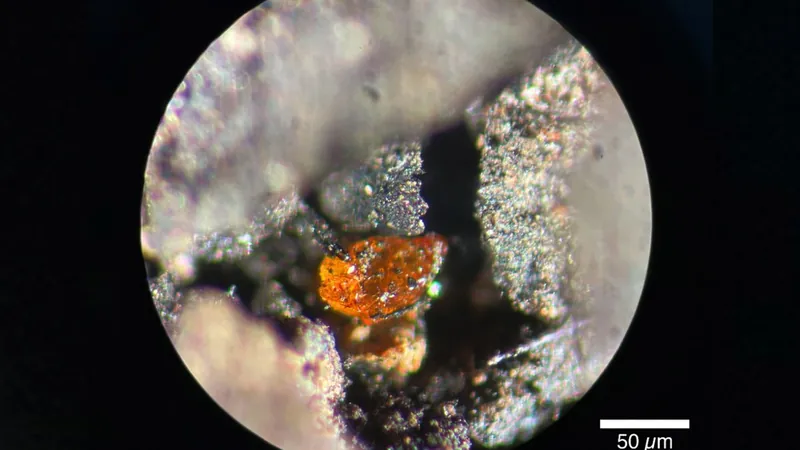
Unlocking a Time Capsule: Antarctic Amber Fossil Reveals Secrets of a 90-Million-Year-Old Rainforest
2024-11-15
Author: Daniel
Groundbreaking Discovery in Antarctica
Researchers have made a groundbreaking discovery in Antarctica, unearthing a piece of amber for the first time in the frozen continent. This tiny golden fragment, found buried beneath the seafloor, offers a unique glimpse into a lush, dinosaur-era rainforest that thrived in Antarctica 90 million years ago, according to a recent study published in the journal Antarctic Science.
The Importance of Amber
Amber, known as fossilized tree resin, is famed for its ability to trap organic material, including plants and insects, in a preserve-like casing that provides insights into ancient environments. This specific fragment measures about 0.002 inches (70 micrometers) across and was recovered from sediment cores obtained at a depth of approximately 3,100 feet (950 meters) off the Pine Island Glacier on Antarctica's west coast.
Antarctica's Cretaceous Period
During the Cretaceous period—ranging from 145 to 66 million years ago—Antarctica was home to a temperate rainforest, strikingly similar to the ones we see in New Zealand today. The warmer climate during this time made it possible for diverse plant life to flourish, and the amber now holds remnants of this lost ecosystem within its protective confines.
Significance of the Discovery
The lead author of the study, Johann Klages, a sedimentologist from the Alfred Wegener Institute in Germany, emphasized the significance of this discovery: 'This finding allows a more direct journey into our planet's past,' he stated. The researchers aim to delve deeper into the details of this ancient forest ecosystem.
Fossils Revealed in Sediment Cores
The sediment cores were initially collected in 2017, revealing astonishing fossils of roots, pollen, spores, and remains from flowering plants, demonstrating some of the most compelling evidence of Antarctica's Cretaceous rainforest. It was during extensive analysis of these samples that scientists discovered the amber fragment, which underwent meticulous examination using fluorescent microscopy.
Preservation and Micro-Inclusions
Not only is the size of the fragment remarkable, but its preservation is noteworthy. The amber contains 'micro-inclusions' from conifer-like tree bark that once thrived in the rainforest, alongside signs of 'pathological resin flow'—a natural defense mechanism trees employ to heal from damage caused by pests or fires, effectively sealing their wounds with resin.
Future Research and Implications
Study co-author Henny Gerschel of the Saxony State Office for the Environment, Agriculture and Geology in Dresden, Germany, remarked on the fragment's high quality, adding that its clarity indicates it most likely remained near the seafloor’s surface for millions of years. 'Amber typically degrades under heat and increased burial pressure,' she explained.
Conclusion
The implications of this discovery extend beyond this single amber piece; researchers believe it may lead to further discoveries in Antarctica that could unveil additional secrets about the prehistoric rainforest and the dinosaurs that inhabited it. As Gerschel noted, 'Our discovery is another piece of the puzzle,' highlighting the vast potential for future research in this unique field of paleontology.
With climate change and environmental preservation at the forefront of global discussions, findings such as these are not only essential for understanding Earth’s historic ecosystems but also for appreciating the impact of climatic shifts over millions of years. The quest for knowledge about Antarctica’s ancient past might yield invaluable lessons for our world today.



 Brasil (PT)
Brasil (PT)
 Canada (EN)
Canada (EN)
 Chile (ES)
Chile (ES)
 Česko (CS)
Česko (CS)
 대한민국 (KO)
대한민국 (KO)
 España (ES)
España (ES)
 France (FR)
France (FR)
 Hong Kong (EN)
Hong Kong (EN)
 Italia (IT)
Italia (IT)
 日本 (JA)
日本 (JA)
 Magyarország (HU)
Magyarország (HU)
 Norge (NO)
Norge (NO)
 Polska (PL)
Polska (PL)
 Schweiz (DE)
Schweiz (DE)
 Singapore (EN)
Singapore (EN)
 Sverige (SV)
Sverige (SV)
 Suomi (FI)
Suomi (FI)
 Türkiye (TR)
Türkiye (TR)
 الإمارات العربية المتحدة (AR)
الإمارات العربية المتحدة (AR)